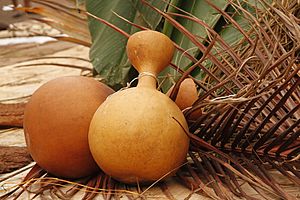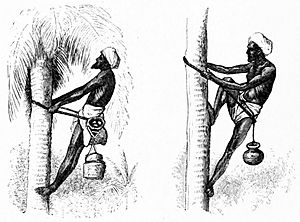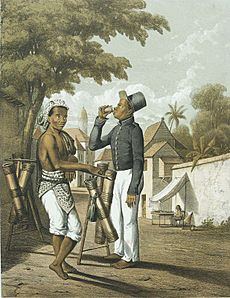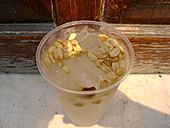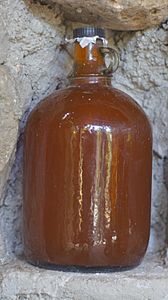Palm wine facts for kids
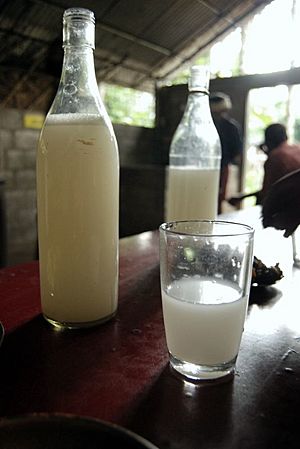
Bottles and a glass of palm wine
|
|
| Type | Alcoholic beverage |
|---|---|
| Country of origin | Worldwide |
Palm wine is a special drink made from the sap of different kinds of palm trees. You can find it in many parts of the world, like Africa, South America, South Asia, and Southeast Asia. It's known by many different names depending on where you are.
Making palm wine can actually help protect palm trees. When farmers can earn money from the sap, the trees become more valuable alive than if they were cut down for wood.
Contents
How Palm Wine is Made
Collecting the Sap

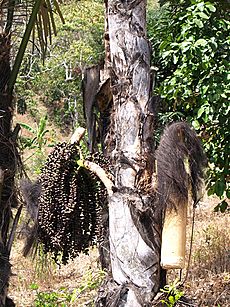
To get the sap, a person called a tapper climbs the palm tree. They make a cut in the flower of the palm tree. Then, they attach a container to catch the sap as it drips out.
When the sap is first collected, it's a sweet, white liquid. It doesn't have alcohol in it yet.
Natural Fermentation
As soon as the sap is collected, it starts to change. Tiny, natural yeasts from the air get into the sap. These yeasts cause the sap to ferment. This means they turn the sugars in the sap into alcohol.
Within about two hours, the sap becomes a sweet, fragrant wine. It has a small amount of alcohol, which can make you feel a bit lightheaded. If you let the wine ferment longer, maybe for a whole day, it becomes stronger and tastes more sour. Some people prefer this taste. If it ferments for too long, it will turn into vinegar instead of wine.
Stronger Palm Drinks
Palm wine can also be made into a stronger drink. This is done by a process called distillation. The stronger drink has different names in different places. For example, it's called arrack or palm feni (liquor) in some areas. In Nigeria, it's often called Emu or "Matango." In Ghana, it's known as akpeteshi.
In the Philippines, a very strong distilled palm drink is called lambanog. It's made from aged palm wine and has a high alcohol content.
Palm Wine Around the World
Africa
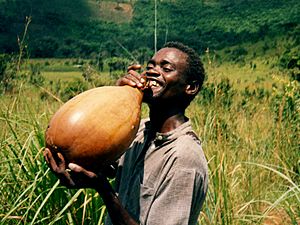
In Africa, palm wine is often made from wild date palms, palmyra palms, or oil palms. In the Democratic Republic of the Congo, it's called malafu.
Palm wine is very important in many African cultures. It's often served at special events like weddings, birth celebrations, and funerals. People also drink it during important festivals. Sometimes, people add medicinal herbs to palm wine. As a sign of respect, some people spill a little palm wine on the ground before drinking. Both men and women enjoy palm wine, though women might drink it in more private settings.
In southeastern Nigeria, the Igbo call palm wine "mmanya ocha," meaning "white drink." It's a key part of traditional Igbo weddings. A young man visiting his future in-laws must bring palm wine as a gift. The amount needed depends on the local customs. This tradition is also seen in parts of Cameroon.
There are different types of palm wine in the Democratic Republic of the Congo. Ngasi comes from the oil palm, dibondo from the raffia palm, cocoti from the coconut palm, and mahusu from a short palm found in grassy areas.
South Asia
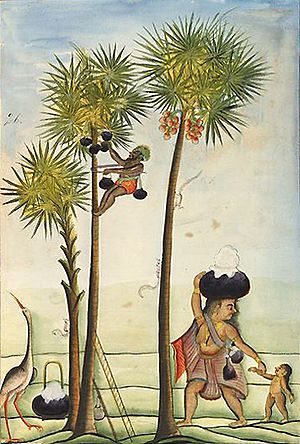
In countries like Bangladesh, India, and Sri Lanka, palm wine is usually made from coconut palms or Palmyra palms. In some parts of India, the sap is boiled down to make a type of unrefined sugar called jaggery.
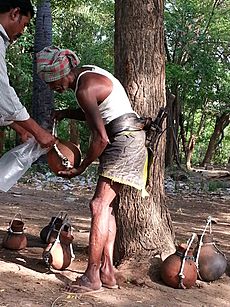
In India, the fresh, unfermented sap is called neera. It's sweet and doesn't have alcohol. A little bit of lime is added to stop it from fermenting. Neera is healthy and rich in potassium.
The fermented palm wine in India is called kallu. It gets sour as it ferments. The best time to drink it is about a day after it's collected, when it's not too sour. If it ferments for too long, it becomes vinegar. Keeping it cold helps it last longer.
In India, palm wine is often sold at special shops called toddy shops. In Tamil Nadu, selling palm wine is sometimes banned. In the states of Telangana and Andhra Pradesh, kallu is a very popular drink, especially after a day's work.
There are two main kinds of kallu in Telangana and Andhra Pradesh: taḍi kallu from Toddy Palmyra trees and īta kallu from silver date palms. Īta kallu is sweet and less strong, while taḍi kallu is stronger and can become quite sour. People often drink kallu right at the trees where it's collected.
In Kerala, India, palm wine is used to help bread rise. It's mixed with rice dough and left overnight. This makes the dough expand and the bread become soft.
Indonesia and Malaysia
In Indonesia and parts of Malaysia, palm wine is called tuak. It's a popular drink during festivals, weddings, and when hosting guests. The Batak people in North Sumatra mix palm sap with raru bark to make their Tuak. This drink is often served at stalls with snacks.
Mexico
Mexican tuba is made from coconut sap and is common in western Mexico. Coconuts were brought to Mexico from the Philippines a long time ago, along with the way to make tuba. The people who collect the sap are called tuberos.
Mexican tuba is also sold as tuba fresca, which is a non-alcoholic version made from fresh coconut sap. Street vendors often sell it in large gourds, mixed with coconut milk, ice, and sugar. It's usually topped with peanuts and diced fruit.
Philippines
Palm wines are widely enjoyed in the Philippines. They are usually made from coconuts, nipa palms, or kaong palms. Palm wines that are fermented for a few days or weeks are generally called tubâ.
There are also stronger versions of tubâ. One is a distilled drink called lambanog (from coconut) or laksoy (from nipa palm). These are usually milky white or clear. Another type is bahalina, which is deep brown-orange because it's aged with bark from mangrove trees.
Other local palm wines include tuhak (from kaong palm sap) and tunggang (from fishtail palm sap).
On Leyte island, red tubâ is aged with bark for up to two years. This makes it dark red and gives it a deep sound when tapped. This aged tubâ is called bahal (for up to six months) and bahalina (for a year or more).
Other Areas
In Tuvalu, you can see palm trees being tapped for toddy near the Funafuti International Airport. In Kiribati, the fresh sap is called Karewe and is a refreshing drink. The fermented sap is an alcoholic drink. Karewe can also be boiled down into a thick, sweet syrup called kamwaimwai.
Animals and Palm Nectar
Some small animals, especially the Southeast Asian pen-tailed treeshrew, drink a lot of fermented palm nectar. The flowers of the bertam palm contain yeast that ferments the nectar. These treeshrews are very good at processing the alcohol and don't seem to get dizzy from it.
Names for Palm Wine
Palm wine has many different names around the world:
| State / Territory / Region | Name used |
|---|---|
| Algeria | لاقمي lāgmi |
| Bangladesh | তাড়ি taṛi, তাড়ু taṛu, tuak |
| Benin | sodavi (distilled), sodabe, atan |
| Cambodia | tek tnart chu (ទឹកត្នោតជុ) |
| Cameroon | mimbo, matango, mbuh, palm wine, tumbu liquor, vin de palme, miluh |
| Central America | vino de coyol |
| People's Republic of China | 棕榈酒 zōng lǘ jiǔ |
| Democratic Republic of the Congo | malafu ya ngasi (Kikongo), masanga ya mbila (Lingala), vin de palme (French) |
| East Timor | tuaka, tua mutin, brandy is called tua sabu |
| Equatorial Guinea | topé (most widespread name), also called bahú in the north and mahú in the south |
| Gabon | toutou |
| Gambia | singer |
| Ghana | doka, nsafufuo, palm wine, yabra, dεha, tér daññ, Akpeteshi (when it is further distilled) |
| Guam | tuba (originated from the Philippines) |
| India |
Toddy in English |
| Indonesia | arak or tuak. In Batak region, North Sumatra: lapo tuak. In South Sulawesi (especially in Tana Toraja): ballo. In North Sulawesi: saguer |
| Ivory Coast | bandji, koutoukou (when it is further distilled) |
| Kenya | mnazi (which means coconut palm in Mijikenda) |
| Kiribati | karewe |
| Libya | لاقبي lāgbi |
| Malaysia | nira (Malay for fresh juice obtained from the blossom of the coconut, palm or sugar-palm, which can be made into sugar or the said palm wine, which is also known as tuak), toddy (English), bahar (Kadazan/Dusun), goribon (Rungus), tuba (Borneo) |
| Maldives | ދޯރާ،ރުކުރާ،މީރާ (dōrā, rukurā, mīrā) |
| Mali | bandji, sibiji, chimichama |
| Marianas | tuba (originated from the Philippines) |
| Mexico | tuba (garnished with peanuts, originated from the Philippines) |
| Myanmar | ထန်းရည် htan yay |
| Namibia | omulunga, palm-wine |
| Nauru | demangi |
| Nepal | tāri तारि |
| Nigeria | palm-wine, palmy, ukọt nsuñ, mmin efik, emu, oguro, tombo liquor, mmanya ngwo, nkwu enu, nkwu ocha |
| Papua New Guinea | segero, tuak |
| Philippines | tubâ (general term for fermented and unfermented palm sap), lambanóg (distilled coconut sap, also vino de coco, dalisay de coco), laksoy (distilled nipa palm sap, also dalisay de nipa, barik), bahalina or bahal (aged tubâ with mangrove bark extracts), tuhak or tubâ sa hidikup (sugar palm wine), tunggang (fishtail palm wine), dalisay (general term for distilled palm liquor) |
| Seychelles | kalou |
| Sierra Leone | poyo, mampama |
| South Africa | ubusulu, injemane |
| Sri Lanka | රා rā (Sinhala), කள்ளු kaḷḷu (Tamil), panam culloo |
| Tanzania | pómbe (which means alcohol) or tembo |
| Thailand | kache (กะแช่), namtanmao (น้ำตาลเมา) |
| Tunisia | لاقمي lāgmi |
| Tuvalu | kaleve (unfermented), kao (fermented), or in English, toddy (unfermented), sour toddy (fermented) |
| Vietnam | rượu dừa; |
a Telugu, Tamil and Malayalam.
b Marathi.
Images for kids
-
Tapping the sap of the immature flower flasks in "arènpalm" (Arenga pinnata), one of the palms used to make palm wine, in Ambon, Moluccas (1919). The wine was called toewak (Dutch), tuak or sagoweer (saguer).
-
Taken in Southern Leyte, Philippines where a tuba gatherer climb the coconut tree to harvest some tuba.
-
Coconut trees, and Toddy gatherers of southern India (1855)
See also
 In Spanish: Vino de palma para niños
In Spanish: Vino de palma para niños
- Arrack, an alcoholic drink made from coconut palm wine in Southeast Asia.
- Coyol wine
- Desi daru
- Madurai Veeran, a deity who enjoys toddy.
- Ogogoro
- Palm-wine music, a type of music from West Africa.
- Pulque
- Sree Muthappan, another deity who enjoys toddy.
- List of Indonesian beverages


